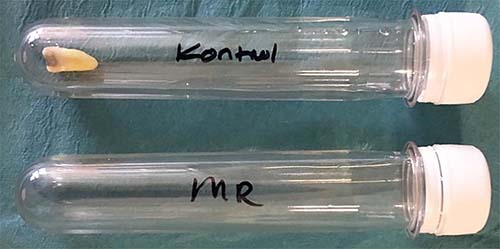High-Strength MRI May Release Mercury from Amalgam Dental Fillings
Lower strength, more commonly used MRI did not affect fillings

Exposure to ultra-high-strength MRI may release toxic mercury from amalgam fillings in teeth, according to a new study in Radiology.
Amalgam fillings, also known as silver fillings, have been a staple of dentistry for many years. Amalgam consists of approximately 50 percent mercury, a known toxin that can cause a host of harmful effects in humans. Despite the presence of mercury, the U.S. Food and Drug Administration considers amalgam fillings safe for adults and children older than age six.
“In a completely hardened amalgam, approximately 48 hours after placing on teeth, mercury becomes attached to the chemical structure, and the surface of the filling is covered with an oxide film layer,” said the study’s lead author, Selmi Yilmaz, PhD, a dentist and faculty member at Akdeniz University in Antalya, Turkey. “Therefore, any mercury leakage is minimal.”
Researchers Evaluate Mercury Leaks
Previous research has found that exposure to the magnetic fields of MRI could cause mercury to leak from amalgam fillings. This concern has been heightened by the recent arrival of ultra-high-strength 7-T scanners in the clinic. The stronger magnetic field of 7-T MRI yields more anatomical detail, but its effects on amalgam dental fillings have not been studied.
Dr. Yilmaz and colleague, Mehmet Zahit Adişen, PhD, evaluated mercury released from dental amalgam after 7-T and 1.5-T MRI in teeth that had been extracted from patients for clinical indications.
The researchers opened two-sided cavities in each tooth and applied amalgam fillings. After nine days, two groups of 20 randomly selected teeth were placed in a solution of artificial saliva immediately followed by 20 minutes of exposure to 1.5-T or 7-T MRI. A control group of teeth was placed in artificial saliva only.
When the researchers analyzed the artificial saliva, the mercury content in the 7-T, 1.5-T and control group was 0.67 ± 0.18, 0.17 ± 0.06 and 0.14 ± 0.15 parts per million (ppm), respectively. At 0.67 ppm, the mercury content in the 7-T group was approximately four times the levels found in the 1.5-T group and the control group.
“In our study, we found very high values of mercury after ultra-high-field MRI,” Dr. Yilmaz said. “This is possibly caused by phase change in amalgam material or by formation of microcircuits, which leads to electrochemical corrosion, induced by the magnetic field.”
An important point of discrimination concerning safety and hazard to human health is the amount of mercury that is absorbed by the vital tissues.
“It is not clear how much of this released mercury form is absorbed by the body,” Dr. Yilmaz said.
Further studies may be warranted and Dr. Yilmaz noted that her research team has three ongoing projects focused on phase and temperature changes of dental amalgam across different magnetic fields.

Web Extras
- Access the study, “Ex Vivo Mercury Release from Dental Amalgam after 7.0-T and 1.5-T MRI,” at https://pubs.rsna.org/doi/10.1148/radiol.2018172597